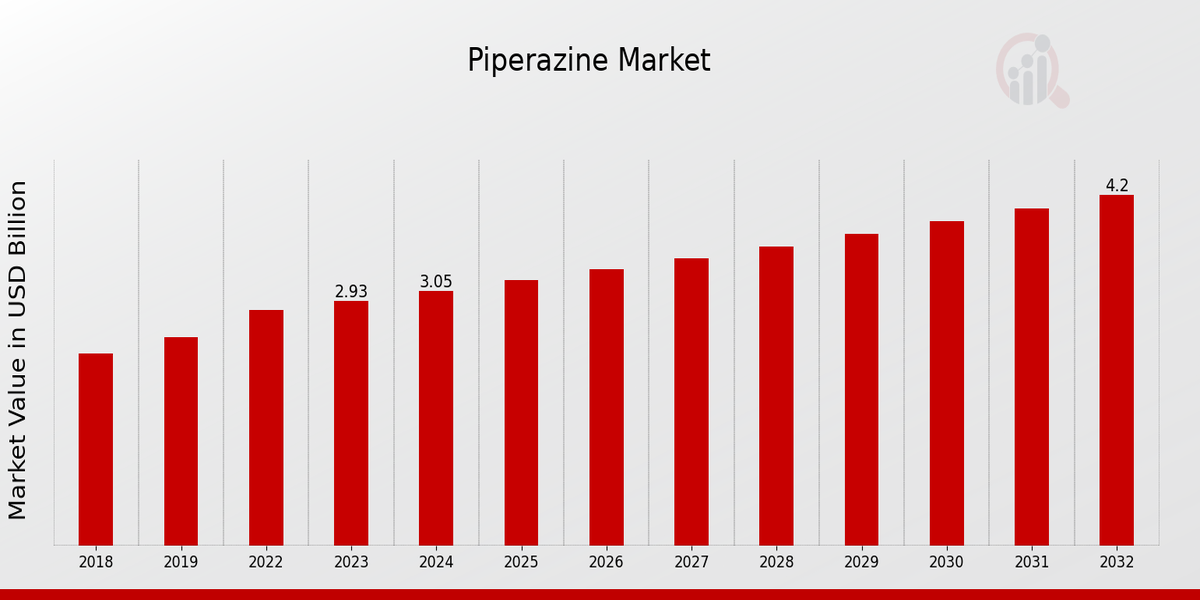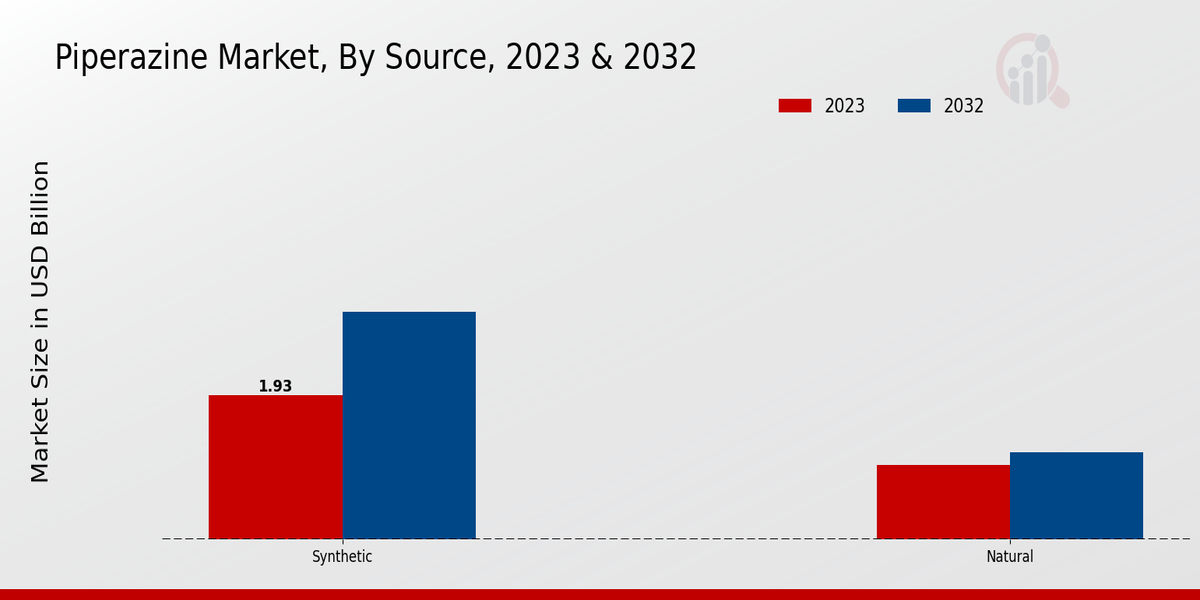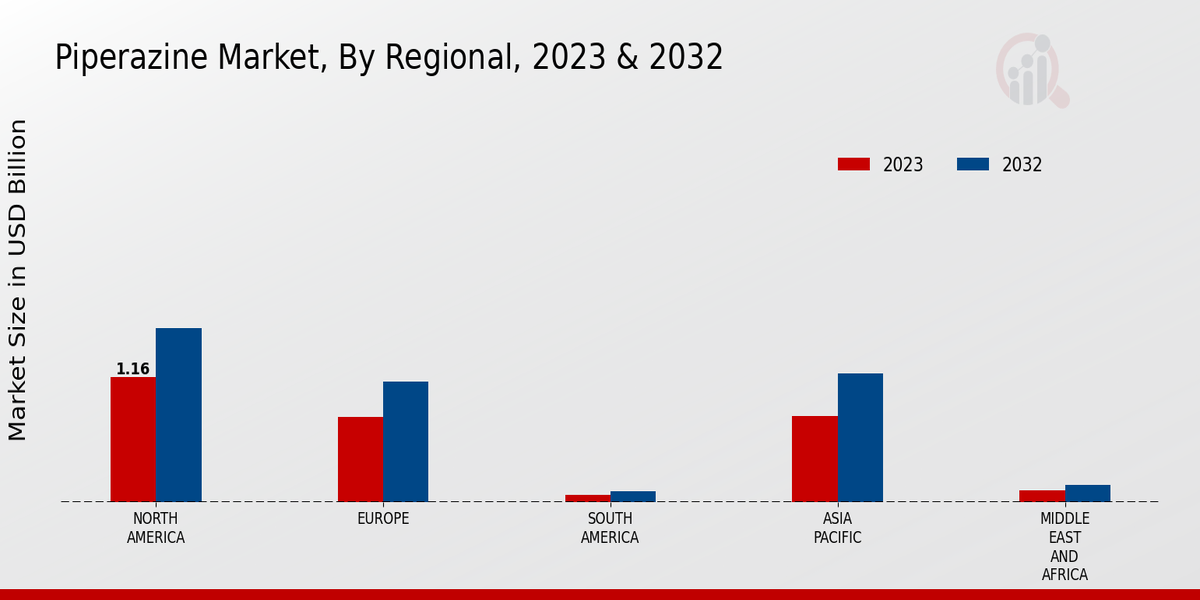Piperazine Market Overview
The Piperazine Market Size was estimated at 3.18(USD Billion) in 2024. The Piperazine Market Industry is expected to grow from 3.31(USD Billion) in 2025 to 4.74(USD Billion) by 2034. The Piperazine Market CAGR (growth rate) is expected to be around 4.07% during the forecast period (2025 - 2034).
Key Piperazine Market Trends Highlighted
Currently, the Piperazine market presents a bright outlook owing to its main market stimulants, for example, the rise of Piperazine pharmaceuticals, which includes antihistamines, antipsychotics, and anthelmintics NRA in place. Because of the increasing rates of allergic diseases, mental health disorders, and parasitic infections, this demand has been stoked, which in turn has fostered growth in the piperazine market.
Another potential area of growth in the piperazine market is in finding new uses for piperazine in healthcare and other industries. Owing to the unique nature of piperazine substances, innovations as drug delivery methods, and agents for enhancing drug effectiveness and corrosion resistance can be realized. As well, the growing application of piperazine derivatives as polyamide & other industrial polymers will create further expansion opportunities for this industry.
The piperazine market has had some of the latest trends which include the new prominent piperazine-based drugs initiation, drug delivery system containing piperazine with new wider uses, and rising emerging market demand. The continuous evolution of research and development in the pharmaceutical industry is likely to transform more piperazine-based applications into clinical practice, thus improving the growth outlook for the market.
Figure1: Piperazine Market, 2018 - 2032 (USD Billion)

Source: Primary Research, Secondary Research, MRFR Database and Analyst Review
Piperazine Market Drivers
Growing Demand for Piperazine in Agrochemicals
Piperazine is increasingly used in the production of agrochemicals, particularly herbicides and fungicides. The rising population and the need to increase agricultural productivity to meet the growing demand for food are driving the growth of the piperazine market in this sector. Piperazine-based agrochemicals are effective against a wide range of pests and diseases, making them a valuable tool for farmers worldwide. The increasing adoption of precision farming techniques and the growing emphasis on sustainable agriculture are further contributing to the demand for piperazine in agrochemicals.
Expanding Pharmaceutical Applications of Piperazine
Piperazine is becoming more popular in the pharmaceutical industry as well. It is used in the synthesis of antihistamines, antidepressants, and antipsychotics. The increasing number of people suffering from mental health diseases and the rising popularity of safe and effective medications are expected to drive the use of piperazine in this sector. Additionally, piperazine-based medications have a number of positive properties; in particular, they are more effective than alternatives, have fewer side effects, and are able to deliver active substances directly to the target tissue.
Rising Adoption of Piperazine in Personal Care Products
Piperazine use in the personal care industry is increasing as new products for hair and skincare benefit from the ability of this compound to enhance hair growth, decrease inflammation, and ameliorate skin texture. Natural and effective shampoo, conditioner, and anti-aging cream demand are increasing because of consumer interest, and because of the increasing disposable income of the population of emerging markets, such products mean the growth of the piperazine market across this sector of the economy.
Piperazine Market Segment Insights
Piperazine Market Source Insights
The Piperazine Market segmentation by Source into Synthetic and Natural is a key aspect influencing market dynamics. Synthetic Piperazine accounted for the majority of the market share in 2023, valued at 2.18 Billion USD and is projected to reach 3.04 Billion USD by 2032, exhibiting a CAGR of 4.2%. This dominance is attributed to the cost-effectiveness and scalability of synthetic production methods. Natural Piperazine, on the other hand, is derived from natural sources such as black pepper and certain plants. It is gaining traction due to growing consumer preference for natural ingredients, particularly in the pharmaceutical and food industries.The Natural Piperazine segment is expected to grow at a CAGR of 3.7% during the forecast period, reaching a valuation of 1.16 Billion USD by 2032. The market growth for both Synthetic and Natural Piperazine is driven by increasing demand from various end-use industries, including pharmaceuticals, agrochemicals, and personal care. The pharmaceutical industry is the largest consumer of Piperazine, utilizing it in the production of antiparasitic drugs, antibiotics, and sedatives. Agrochemicals utilize Piperazine as an active ingredient in pesticides and herbicides.Personal care products, such as cosmetics and toiletries, leverage Piperazine's antimicrobial and anti-inflammatory properties.
Figure2: Piperazine Market, By Sour ce, 2023 & 2032 (USD billion)
ce, 2023 & 2032 (USD billion)
Source: Primary Research, Secondary Research, MRFR Database and Analyst Review
Piperazine Market End-Use Industry Insights
The end-use industry segment of the Piperazine Market offers valuable insights into the diverse applications of Piperazine. In 2023, the pharmaceutical industry held the largest market share, driven by the increasing demand for piperazine derivatives in the production of active pharmaceutical ingredients (APIs) for various medications. The agrochemicals sector is another significant end-use industry, with piperazine compounds utilized as intermediates in the synthesis of herbicides, fungicides, and plant growth regulators. Corrosion inhibitors, personal care products, and other industries also contribute to the market growth.The Piperazine Market is expected to reach a valuation of USD 4.2 billion by 2032, expanding at a CAGR of 4.07% during the forecast period.
Piperazine Market Application Insights
The Piperazine Market is segmented based on application into Antiparasitic Drugs, Herbicides, Corrosion Inhibitors, Emulsifiers, and Others. Among these, the Antiparasitic Drugs segment held the largest market share in 2023, accounting for over 40% of the Piperazine Market revenue. The growth of this segment is attributed to the increasing prevalence of parasitic diseases, such as malaria and hookworm infections, in developing regions. The Herbicides segment is projected to be the fastest-growing segment during the forecast period, with a CAGR of over 5%.The increasing demand for herbicides in agriculture to control weeds and improve crop yield is driving the growth of this segment. Corrosion Inhibitors and Emulsifiers segments are also expected to witness significant growth during the forecast period due to their increasing demand in various industries.
Piperazine Market Distribution Channel Insights
The distribution channel segment plays a critical role in the pipeline market. In 2023, the direct sales channel dominated the market, accounting for approximately 45% of the Piperazine Market revenue. Direct sales involve manufacturers selling directly to customers, providing personalized service and technical support. Distributors, on the other hand, act as intermediaries between manufacturers and customers, handling storage, transportation, and order fulfillment. Distributors accounted for around 30% of the market share in 2023.Online platforms are gaining traction, particularly for smaller manufacturers and customers seeking convenience and wider product selection. The online channel is expected to witness significant growth in the coming years, driven by the increasing adoption of e-commerce and the proliferation of online marketplaces.
Piperazine Market Regional Insights
The regional segmentation of the Piperazine Market presents distinct market dynamics and growth opportunities. North America is projected to account for a significant share of the market in 2024, driven by factors such as rising demand from the pharmaceutical industry and increasing healthcare expenditure. Europe is another key region with a large pharmaceutical and chemical industry base. The Asia-Pacific region is expected to witness robust growth over the forecast period, owing to the expanding pharmaceutical sector and increasing disposable income.South America the Middle East, and Africa regions are anticipated to contribute a smaller but growing share to the market, driven by the rising healthcare infrastructure and pharmaceutical manufacturing in these regions. The regional segmentation provides insights into the specific market dynamics, growth drivers, and challenges in each region, enabling businesses to tailor their strategies and capitalize on regional growth opportunities.
Figure3: Piperazine Market, By Regional, 2023 & 2032 (USD billion)

Source: Primary Research, Secondary Research, MRFR Database and Analyst Review
Piperazine Market Key Players And Competitive Insights
Major players in the Piperazine Market industry are constantly striving to gain a competitive edge through strategic initiatives such as product innovation, mergers and acquisitions, and geographical expansion. Leading Piperazine Market players are investing heavily in research and development to introduce new and improved products that cater to evolving customer needs. Partnerships and collaborations with other industry players are also becoming increasingly common as companies seek to leverage synergies and expand their market reach. The Piperazine Market development is driven by factors such as rising demand from the pharmaceutical industry, increasing adoption in agricultural applications, and growing awareness of the product's versatility.BASF SE, a leading player in the Piperazine Market, has a strong presence and a diverse portfolio of Piperazine products. The company's focus on innovation and sustainability has enabled it to maintain its position as a market leader. BASF SE has a well-established distribution network and a dedicated team of technical experts providing comprehensive support to its customers. The company's commitment to quality and customer satisfaction has made it a preferred partner for many businesses in the Piperazine Market.Evonik Industries AG, a prominent competitor in the Piperazine Market, is known for its high-quality piperazine products and its commitment to environmental stewardship. The company has invested significantly in expanding its production capacity and developing new, innovative applications for piperazine. Evonik Industries AG's strong focus on research and development has resulted in a portfolio of patented technologies and a deep understanding of the Piperazine Market. The company's reach and extensive distribution network enable it to serve customers in various industries, including pharmaceuticals, agrochemicals, and personal care.
Key Companies in the Piperazine Market Include
-
Merck KGaA
-
Evonik Industries AG
-
Solvay S.A.
-
Chevron Phillips Chemical Company LP
-
Borealis AG
-
Dow Chemical Company
-
ExxonMobil Corporation
-
LyondellBasell Industries Holdings B.V.
-
BASF
-
Albemarle Corporation
-
SABIC
-
INEOS Group Ltd.
-
Huntsman International LLC
-
Shell Chemicals
Piperazine Market Industry Developments
The increasing prevalence of parasitic infections and the growing demand for piperazine-based drugs in veterinary applications are key factors driving market expansion. Piperazine's effectiveness against various parasitic worms, including roundworms and hookworms, in both humans and animals contributes to its widespread adoption. Additionally, the rising demand for piperazine in the pharmaceutical and chemical industries further supports market growth.
Piperazine Market Segmentation Insights
Piperazine Market Source Outlook
Piperazine Market End-Use Industry Outlook
- Pharmaceuticals
- Agrochemicals
- Corrosion Inhibitors
- Personal Care
- Others
Piperazine Market Application Outlook
- Antiparasitic Drugs
- Herbicides
- Corrosion Inhibitors
- Emulsifiers
- Others
Piperazine Market Distribution Channel Outlook
- Direct Sales
- Distributors
- Online Platforms
Piperazine Market Regional Outlook
- North America
- Europe
- South America
- Asia Pacific
- Middle East and Africa
| Report Attribute/Metric |
Details |
| Market Size 2024 |
3.18(USD Billion) |
| Market Size 2025 |
3.31(USD Billion) |
| Market Size 2034 |
4.74(USD Billion) |
| Compound Annual Growth Rate (CAGR) |
4.07% (2025 - 2034) |
| Report Coverage |
Revenue Forecast, Competitive Landscape, Growth Factors, and Trends |
| Base Year |
2024 |
| Market Forecast Period |
2025 - 2034 |
| Historical Data |
2020 - 2024 |
| Market Forecast Units |
USD Billion |
| Key Companies Profiled |
Merck KGaA, Evonik Industries AG, Solvay S.A., Chevron Phillips Chemical Company LP, Borealis AG, Dow Chemical Company, ExxonMobil Corporation, LyondellBasell Industries Holdings B.V., BASF, Albemarle Corporation, SABIC, INEOS Group Ltd., Huntsman International LLC, Shell Chemicals |
| Segments Covered |
Source, End-Use Industry, Application, Distribution Channel, Regional |
| Key Market Opportunities |
Growing demand in the pharmaceutical industry Expanding applications in agrochemicals Increasing use in the oil and gas industry Rising consumption in personal care products Emerging markets with untapped potential. |
| Key Market Dynamics |
Growing pharmaceutical industry Increasing demand from end-use industries Technological advancements Government initiatives and Rising environmental concerns. |
| Countries Covered |
North America, Europe, APAC, South America, MEA |
Frequently Asked Questions (FAQ) :
The piperazine market is expected to be valued at USD 3.31 billion in 2025.
The piperazine market is expected to reach a valuation of USD 4.74 billion by 2034.
The piperazine market is anticipated to grow at a CAGR of 4.07% from 2025 to 2034.
North American region is expected to account for the largest market share in the piperazine market.
The pharmaceutical segment is expected to contribute the highest revenue to the piperazine market.
Some of the key competitors in the piperazine market include BASF, Evonik Industries, Lonza, and Solvay.
The growing demand for piperazine in the pharmaceutical industry, increasing use in personal care products, and rising demand for piperazine derivatives are major factors driving the growth of the piperazine market.
The stringent regulations governing the production and use of piperazine, as well as the environmental concerns associated with its production, pose challenges to the piperazine market.
The growing adoption of green and sustainable production processes, the development of novel applications for piperazine derivatives, and the increasing demand for piperazine in emerging economies are key trends shaping the piperazine market.
The untapped potential in emerging markets, the growing demand for piperazine in the healthcare industry, and the development of new applications for piperazine derivatives present opportunities for growth in the piperazine market.







 ce, 2023 & 2032 (USD billion)
ce, 2023 & 2032 (USD billion)








